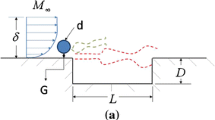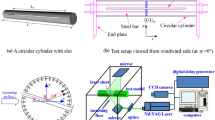Abstract
Supersonic flow over an open cavity can create intense pressure loads on the surfaces within the cavity. In order to combat these loads, the development of a control scheme to reduce them is becoming increasingly important for many engineering applications. The present study implements steady leading edge blowing through various configurations of spanwise-aligned rectangular leading edge slots. The effects of this control on the flow field were examined to determine the suppression mechanisms exploited by the leading edge blowing. The cavity studied here had a length-to-depth ratio of 6 and was placed in a freestream flow with a Mach number of 1.4. Actuators with one continuous slot and three and five segmented slots spanning the width of the cavity were installed at the leading edge. Surface pressure reductions of nearly 45% were achieved on the aft wall of the cavity using the 5-slot configuration. Velocity field measurements acquired through 2-component (streamwise-aligned measurement plane) and 3-component stereoscopic (cross-stream-aligned measurement plane) particle image velocimetry revealed the presence of streamwise-aligned vortices created by the segmented slots. These act to significantly alter the shear layer formed at the mouth of the cavity creating highly three-dimensional flow field features.













Similar content being viewed by others
References
Arunajatesan S, Kannepalli C, Sinha N, Sheehan M, Alvi F, Shumway G, Ukeiley L (2009) Suppression of cavity loads using leading edge blowing. AIAA J 47(5):1133–1144
Bendat JS, Piersol AG (1986) Random data. Wiley, New York
Brown GL, Roshko A (1974) On density effects and large structure in turbulent mixing layers. J Fluid Mech 64:775–816
Bueno PC, Ünalmis ÖH, Clemens NT, Dolling DS (2002) The effects of upstream mass injection on a Mach 2 Cavity Flow, AIAA Paper 2002-0663
Cattafesta LN, Garg S, Choudhari M, Li F (1997) Active control of flow-induced cavity resonance, AIAA Paper 1997–1804
Cattafesta LN, Song Q, Williams DR, Rowley CW, Alvi FS (2008) Active control of flow-induced cavity oscillations. Prog Aerosp Sci 44:479–502
Dudley JG (2010) The mechanisms for passive suppression of fluctuating surface pressure in a supersonic cavity flow. PhD dissertation, University of Florida, Gainesville
Dudley J, Ukeiley L (2010) Suppression of fluctuating surface pressures in a supersonic cavity flow. AIAA Paper 2010–4947
Dudley J, Shumway G, Tinney C, Ukeiley L (2008) Flow characteristics of the University of Florida-REEF Supersonic Wind Tunnel, AIAA Paper 2008–3942
Grant I, Owens EH (1990) Confidence interval estimates in PIV measurements of turbulent flows. Appl Opt 29(10):1400–1402
Griffin J, Schultz T, Holman R, Ukeiley LS, Cattafesta LN (2010) Application of multivariate outlier detection to fluid velocity measurements. Exp Fluids 49(1):305–317
Heller H, Delfs J (1996) Cavity pressure oscillations: the generating mechanisms visualized. J Sound Vib 196:248
Hubert M, Van der Veeken S (2008) Outlier detection for skewed data. J Chemometr 22(3–4):235–246
Krishnamurty K (1955) Acoustic radiation from two-dimensional rectangular cutouts in aerodynamic surfaces. Technical note 3847, NACA
Lamp AM, Chokani N (1997) Computation of cavity flows with suppression using jet blowing. J Aircr 34(4):545–551
Lawson S, Barakos G (2011) Review of numerical simulations for high-speed, turbulent cavity flows. Prog Aerosp Sci 47:186–216
Murray N, Sallstrom E, Ukeiley L (2009) Properties of subsonic open cavity flow fields. Phys Fluids 21:16
Rockwell D, Naudascher E (1978) Review: self sustaining oscillations of flow past cavities. J Fluid Eng 100:152–165
Roshko A (1955) Some measurements of flow in a rectangular cutout. Technical note 3488, NACA
Rossiter, J (1964) Wind-tunnel experiments on the flow over rectangular cavities at subsonic and transonic speeds. Aeronautical Research Council Technical Report 3488
Rowley CW, Williams DR (2006) Dynamics and control of high Reynolds number flow over open cavities. Annu Rev Fluid Mech 38:251–276
Shaw L (1998) Active control of cavity acoustics, AIAA Paper 98–2347
Ukeiley L, Sheehan M, Coiffet F, Alvi F, Arunajatesan S, Jansen B (2008) Control of pressure loads in geometrically complex cavities. J Aircr 45(3):1014–1024
Unalmis O, Clemens N, Dolling D (2001) Experimental study of shear layer/acoustics coupling in Mach 5 cavity flow. AIAA J 39:242
Vakili AD, Gauthier C (1994) Control of cavity flow by upstream mass-injection. J Aircr 31(1):169–174
Zhuang N, Alvi FS, Alkislar MB, Shih C (2006) Supersonic cavity flows and their control. AIAA J 44(9):11
Acknowledgments
The authors would like to acknowledge the support of both AFOSR through a program managed by Dr. D. Smith and the Florida Center for Advanced Aero Propulsion (FCAAP).
Author information
Authors and Affiliations
Corresponding author
Rights and permissions
About this article
Cite this article
Lusk, T., Cattafesta, L. & Ukeiley, L. Leading edge slot blowing on an open cavity in supersonic flow. Exp Fluids 53, 187–199 (2012). https://doi.org/10.1007/s00348-012-1282-8
Received:
Revised:
Accepted:
Published:
Issue Date:
DOI: https://doi.org/10.1007/s00348-012-1282-8




